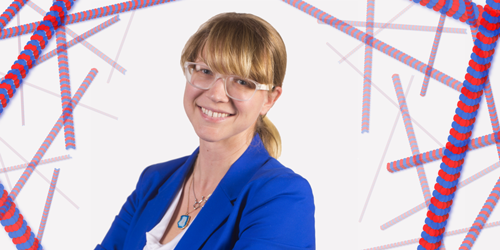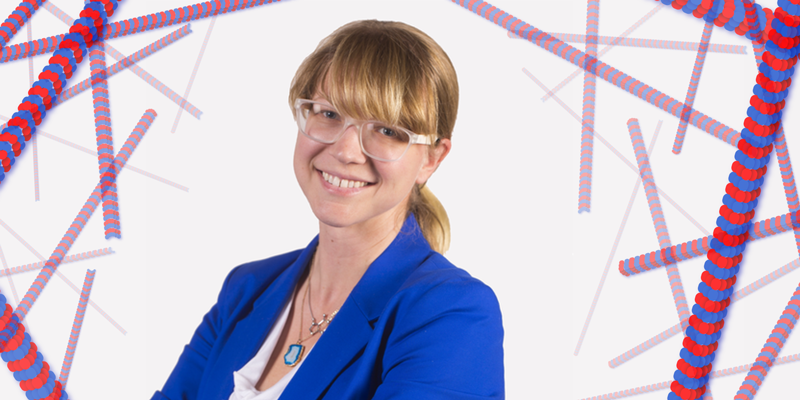Q&A: Examining a Cell’s Shape-Shifting “Bones”
Jennifer Ross puts her decision to become a physicist down to stubbornness. Told at a young age that math and physics were “too hard for girls,” she saw the statement as a challenge and set her mind to mastering both subjects. Today, Ross is a professor of biophysics at the University of Massachusetts, Amherst, where she studies how cells get their stability and shape from structural molecules called microtubules. She, like others, believes that the physical rules governing the behavior of these molecules are the same for all living things. By uncovering those rules, Ross hopes to find a blueprint for making synthetic materials that spontaneously assemble and disassemble without human intervention. In an interview with Physics, Ross explains her fascination with microtubules, the prospects for self-repairing materials, and an annual movie-making tradition in her lab.
–Katherine Wright
What are microtubules?
They are extremely long, thin, stiff protein rods, with a tube shape that makes them look like skinny, unfilled cannoli. Microtubules act like a cell’s bones in that they work together to help give a cell its structure. But unlike bones, microtubules can disassemble and reform.
Microtubules are found inside nearly everything from yeast cells to human cells—that's one of the reasons I love them. In plant cells, for example, microtubules run around the edge of each cell, providing each cell—and the plant—with structural stability. If that structure gets messed up, the plant can no longer support its own weight, and it collapses.
Why is it important that microtubules can break apart and reassemble?
A hallmark of biological materials is their ability to continually collapse and reorganize their structures into different shapes. This restructuring allows biological materials to self-repair, something that we don’t see in other materials. When a pothole appears on a street, the street doesn't say, “Hey, I have a hole in me, I'm going to fix that hole myself.” Instead, a whole crew of workers has to come out to mend it. My hope is that by understanding how biological materials rearrange themselves, we can learn how to make our own self-repairing materials.
Do you think synthetic self-healing materials could become reality?
I think we’re some ways off from creating such materials, but the foundations are being laid. We know that microtubules can self-repair because they exist in a sea of their subunit proteins. But it’s not yet clear how we would realize a material that has a similarly constant stream of its subcomponents.
What specific aspect of microtubule behavior do you study in your lab?
I am interested in how microtubules self-organize into different shapes and structures without a crew foreman—without anybody telling them what to do. To understand how this happens, my group studies the self-assembly of microtubules under different conditions, trying to recreate the structures found in real cells.
What have you seen?
We have experiments where we allow microtubules to grow while we push them together using a “crowding agent,” which is basically a set of fluffy molecules that take up space. The agent causes the microtubules to form a football-shaped bundle called a mitotic spindle, a structure that develops naturally in cells when they divide in two during replication. The spindle helps keep the copied chromosomes separate from the originals.
Recently, we found that length determines whether microtubules form ordered structures. When we let microtubules grow freely in a test tube, they have a wide distribution of lengths, and that messes up the self-assembly process. But when we control the growth to have just one length, the microtubules arrange into well-defined shapes. Researchers have long known that cells have the machinery to control microtubule length. But to actually find that length has a qualitative effect on microtubule organization—that was cool.
On a different topic: As well as performing experiments with microtubules, your group dabbles in film making. Can you tell me about that?
The videos are a team-building exercise. My group takes one day over the summer to put together a spoof of a music video, where the song lyrics relate to the awesomeness of the lab.
We do hair and makeup and bring in crazy lighting. Then we spend the day filming everyone running around and dancing in various outfits. It's just a fun day.
The lab also has a cleanup day, with no video. Everybody comes in—including me—and we wipe the dust off of every light bulb and wash every piece of glassware. We then bond over the disgusting things we discover growing in the lab.
Katherine Wright is a Senior Editor for Physics.
Know a physicist with a knack for explaining their research to others? Write to physics@aps.org. All interviews are edited for brevity and clarity.





